Current HRM Issues in CSR and Sustainability
VerifiedAdded on 2023/06/09
|9
|2141
|69
AI Summary
This essay identifies research gaps regarding current HRM issues in CSR and sustainability. It discusses the relationship between organizational culture, transformational leadership, and business performance. It also explores the impact of customer orientation of service employees on customer satisfaction, commitment, and retention. The essay investigates the entrepreneurial orientation of small business performance and the impact of attributes on brand equity. Finally, it examines the relative importance of customer satisfaction and trust as determinants of customer retention and positive word of mouth.
Contribute Materials
Your contribution can guide someone’s learning journey. Share your
documents today.
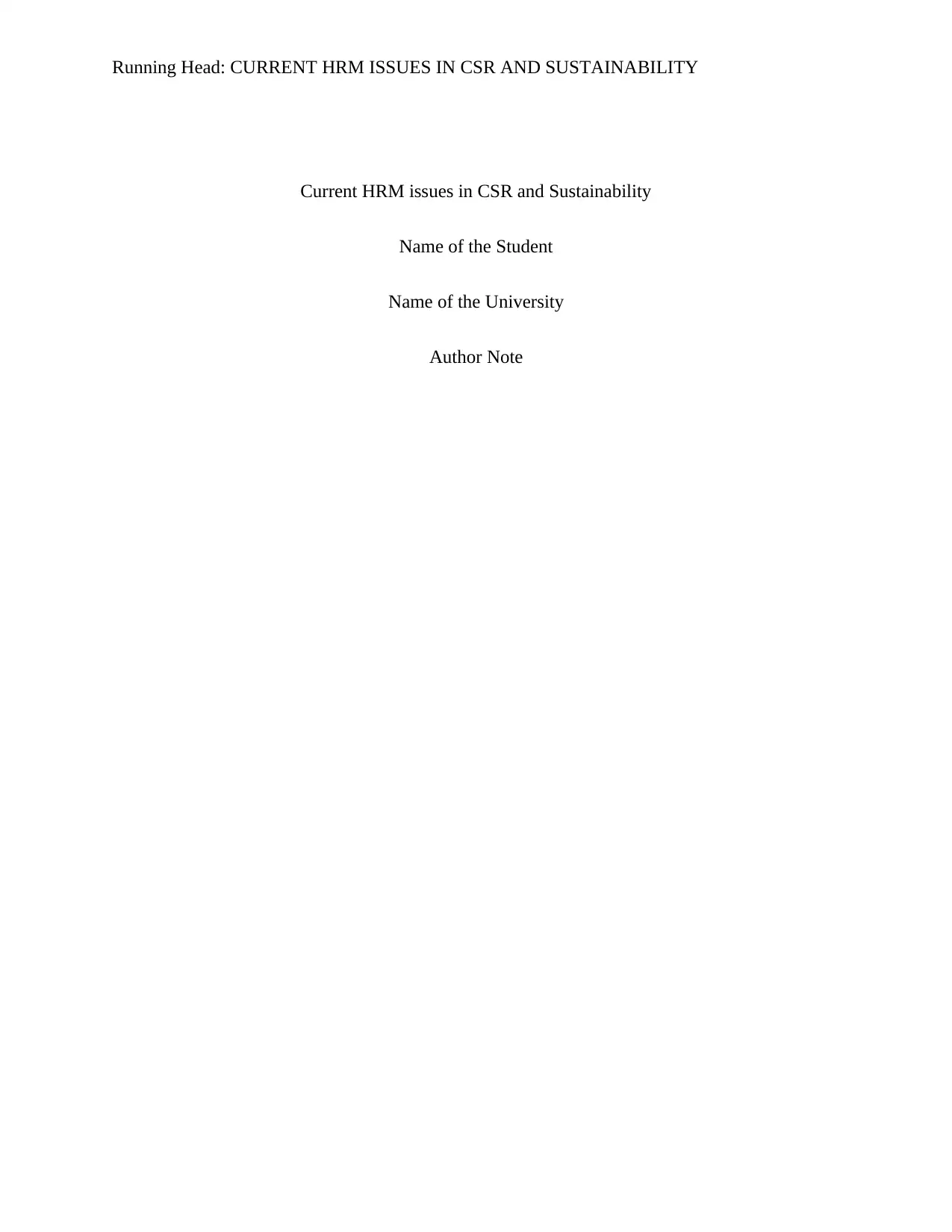
Running Head: CURRENT HRM ISSUES IN CSR AND SUSTAINABILITY
Current HRM issues in CSR and Sustainability
Name of the Student
Name of the University
Author Note
Current HRM issues in CSR and Sustainability
Name of the Student
Name of the University
Author Note
Secure Best Marks with AI Grader
Need help grading? Try our AI Grader for instant feedback on your assignments.

1CURRENT HRM ISSUES IN CSR AND SUSTAINABILITY
Topic- An Essay identifying the research gaps regarding current HRM issues in
CSR and sustainability
In the first article is titled “Organizational culture and transformational leadership as
predictors of business unit performance”, written by Athena Xenikou and Maria Simosi
published in the Journal of managerial psychology (2006). The article is focused on the
relationship between organizational cultural orientation and transformational leadership and their
joint impact on the business performances (Xenikou & Simosi, 2006). The article proceeds by
giving a brief literature review on the same topic showing that there are specific cultural
orientations that are advantageous for performance. As far as transformational leadership is
concerned, the review shows that the qualities steers the performance to achieve higher profits
(Xenikou & Simosi, 2006). On the basis of the previous literature reviews the article suggests
that there are mainly wo kinds of cultural orientation that forecast effectiveness in an
organization. The first trait is ‘humanistic orientation’ or ‘human relationships’ within the work
area (Xenikou & Simosi, 2006). It includes company members, teamwork, involvement in
decision making, and social support. The humanistic orientation somehow covers the basis
corporate social responsibility too. The second trait is ‘achievement orientation’ which includes
the organizational practices and values, goal setting, effectiveness, experimentation and others
(Xenikou & Simosi, 2006). The article talks about the cross-cultural issues that HRM faces
within an organization. The article talks more about the organizational culture and leadership that
result in performance effectiveness. It is apparent that the research lacks the value of CSR in
supporting the culture and prosperity of an organization (Shen & Benson, 2016). The research
gap needs to be filled up in future for better understanding.
Topic- An Essay identifying the research gaps regarding current HRM issues in
CSR and sustainability
In the first article is titled “Organizational culture and transformational leadership as
predictors of business unit performance”, written by Athena Xenikou and Maria Simosi
published in the Journal of managerial psychology (2006). The article is focused on the
relationship between organizational cultural orientation and transformational leadership and their
joint impact on the business performances (Xenikou & Simosi, 2006). The article proceeds by
giving a brief literature review on the same topic showing that there are specific cultural
orientations that are advantageous for performance. As far as transformational leadership is
concerned, the review shows that the qualities steers the performance to achieve higher profits
(Xenikou & Simosi, 2006). On the basis of the previous literature reviews the article suggests
that there are mainly wo kinds of cultural orientation that forecast effectiveness in an
organization. The first trait is ‘humanistic orientation’ or ‘human relationships’ within the work
area (Xenikou & Simosi, 2006). It includes company members, teamwork, involvement in
decision making, and social support. The humanistic orientation somehow covers the basis
corporate social responsibility too. The second trait is ‘achievement orientation’ which includes
the organizational practices and values, goal setting, effectiveness, experimentation and others
(Xenikou & Simosi, 2006). The article talks about the cross-cultural issues that HRM faces
within an organization. The article talks more about the organizational culture and leadership that
result in performance effectiveness. It is apparent that the research lacks the value of CSR in
supporting the culture and prosperity of an organization (Shen & Benson, 2016). The research
gap needs to be filled up in future for better understanding.

2CURRENT HRM ISSUES IN CSR AND SUSTAINABILITY
The next article is entitled “Customer orientation of service employees: Its impact on
customer satisfaction, commitment, and retention” written by Thorsten Hennig-Thurau,
published in the International Journal of Service Industry Management (2004). The article
emphasizes the dependency of an organization on the service employees because the customers
count on the demeanor of the service employee to judge the standard of the service (Hennig-
Thurau, 2004). Thus the economic success of an organization depends on the employee’s
customer orientation power. This paper employs the conceptualization proposed by Hennig-
Thurau and Thurau and examines a COSE dimensional model and consequences that come from
the side of customers. The article follows many literature reviews on the COSE structure that
propounds a new one (Hennig-Thurau, 2004). This model works as a keystone of the customer-
sided con sequences. The paper closes by concluding the implications and findings of service
practice research. The COSE model comprises of four dimensions. They are; the skill dimension
including the social skill and technical skill, the motivation dimension and the decision making
capability of the service employee (Hennig-Thurau, 2004). Building strong relationships with the
customers and maintaining them on a long-term basis is considered to be the best strategy
focused by most of the business firms. The article postulates that a customer has a lot of
expectations from the service provider and when these expectations are met and even exceeded,
it eventually influences the economy and reputations of the organization (Hennig-Thurau, 2004).
This article comparatively more informative than the previous one regarding the CSR issues and
sustainability, but the ‘social responsibility’ that an organization should have for the society in
which it resides is a little unclear (Saeidi et al ., 2015). It talks widely about the social
organizational behaviors of the employees towards the customers but evades the other
responsibilities towards the society.
The next article is entitled “Customer orientation of service employees: Its impact on
customer satisfaction, commitment, and retention” written by Thorsten Hennig-Thurau,
published in the International Journal of Service Industry Management (2004). The article
emphasizes the dependency of an organization on the service employees because the customers
count on the demeanor of the service employee to judge the standard of the service (Hennig-
Thurau, 2004). Thus the economic success of an organization depends on the employee’s
customer orientation power. This paper employs the conceptualization proposed by Hennig-
Thurau and Thurau and examines a COSE dimensional model and consequences that come from
the side of customers. The article follows many literature reviews on the COSE structure that
propounds a new one (Hennig-Thurau, 2004). This model works as a keystone of the customer-
sided con sequences. The paper closes by concluding the implications and findings of service
practice research. The COSE model comprises of four dimensions. They are; the skill dimension
including the social skill and technical skill, the motivation dimension and the decision making
capability of the service employee (Hennig-Thurau, 2004). Building strong relationships with the
customers and maintaining them on a long-term basis is considered to be the best strategy
focused by most of the business firms. The article postulates that a customer has a lot of
expectations from the service provider and when these expectations are met and even exceeded,
it eventually influences the economy and reputations of the organization (Hennig-Thurau, 2004).
This article comparatively more informative than the previous one regarding the CSR issues and
sustainability, but the ‘social responsibility’ that an organization should have for the society in
which it resides is a little unclear (Saeidi et al ., 2015). It talks widely about the social
organizational behaviors of the employees towards the customers but evades the other
responsibilities towards the society.

3CURRENT HRM ISSUES IN CSR AND SUSTAINABILITY
Secure Best Marks with AI Grader
Need help grading? Try our AI Grader for instant feedback on your assignments.
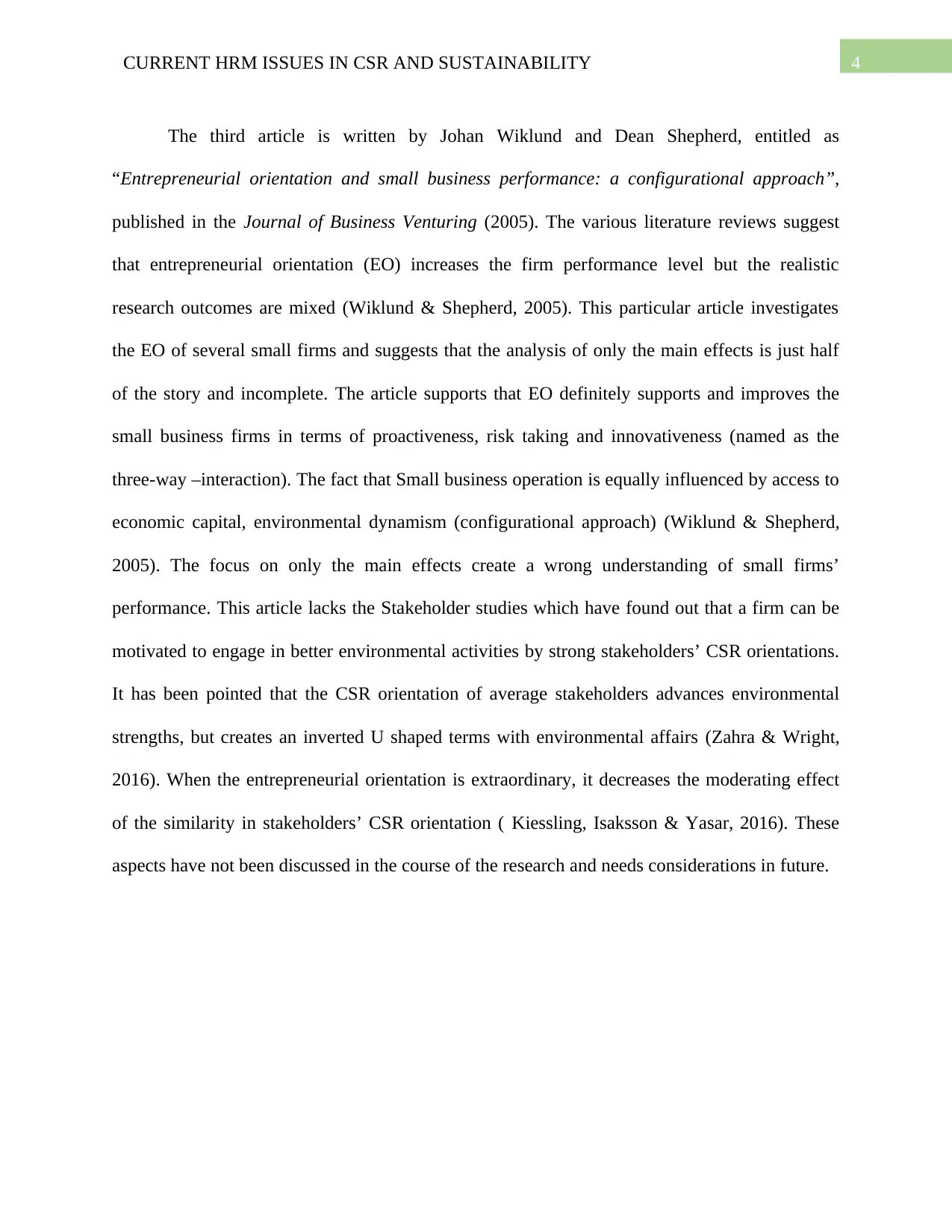
4CURRENT HRM ISSUES IN CSR AND SUSTAINABILITY
The third article is written by Johan Wiklund and Dean Shepherd, entitled as
“Entrepreneurial orientation and small business performance: a configurational approach”,
published in the Journal of Business Venturing (2005). The various literature reviews suggest
that entrepreneurial orientation (EO) increases the firm performance level but the realistic
research outcomes are mixed (Wiklund & Shepherd, 2005). This particular article investigates
the EO of several small firms and suggests that the analysis of only the main effects is just half
of the story and incomplete. The article supports that EO definitely supports and improves the
small business firms in terms of proactiveness, risk taking and innovativeness (named as the
three-way –interaction). The fact that Small business operation is equally influenced by access to
economic capital, environmental dynamism (configurational approach) (Wiklund & Shepherd,
2005). The focus on only the main effects create a wrong understanding of small firms’
performance. This article lacks the Stakeholder studies which have found out that a firm can be
motivated to engage in better environmental activities by strong stakeholders’ CSR orientations.
It has been pointed that the CSR orientation of average stakeholders advances environmental
strengths, but creates an inverted U shaped terms with environmental affairs (Zahra & Wright,
2016). When the entrepreneurial orientation is extraordinary, it decreases the moderating effect
of the similarity in stakeholders’ CSR orientation ( Kiessling, Isaksson & Yasar, 2016). These
aspects have not been discussed in the course of the research and needs considerations in future.
The third article is written by Johan Wiklund and Dean Shepherd, entitled as
“Entrepreneurial orientation and small business performance: a configurational approach”,
published in the Journal of Business Venturing (2005). The various literature reviews suggest
that entrepreneurial orientation (EO) increases the firm performance level but the realistic
research outcomes are mixed (Wiklund & Shepherd, 2005). This particular article investigates
the EO of several small firms and suggests that the analysis of only the main effects is just half
of the story and incomplete. The article supports that EO definitely supports and improves the
small business firms in terms of proactiveness, risk taking and innovativeness (named as the
three-way –interaction). The fact that Small business operation is equally influenced by access to
economic capital, environmental dynamism (configurational approach) (Wiklund & Shepherd,
2005). The focus on only the main effects create a wrong understanding of small firms’
performance. This article lacks the Stakeholder studies which have found out that a firm can be
motivated to engage in better environmental activities by strong stakeholders’ CSR orientations.
It has been pointed that the CSR orientation of average stakeholders advances environmental
strengths, but creates an inverted U shaped terms with environmental affairs (Zahra & Wright,
2016). When the entrepreneurial orientation is extraordinary, it decreases the moderating effect
of the similarity in stakeholders’ CSR orientation ( Kiessling, Isaksson & Yasar, 2016). These
aspects have not been discussed in the course of the research and needs considerations in future.
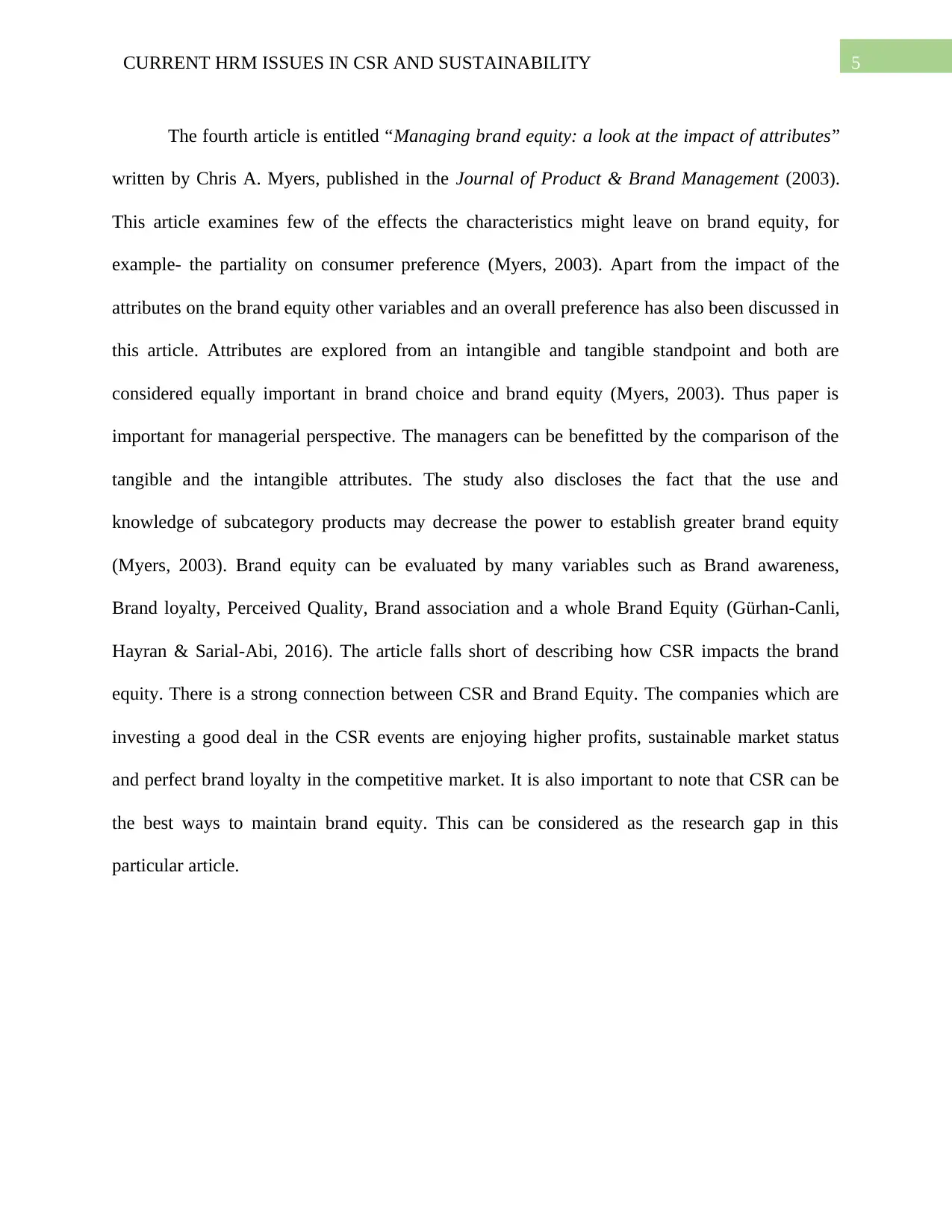
5CURRENT HRM ISSUES IN CSR AND SUSTAINABILITY
The fourth article is entitled “Managing brand equity: a look at the impact of attributes”
written by Chris A. Myers, published in the Journal of Product & Brand Management (2003).
This article examines few of the effects the characteristics might leave on brand equity, for
example- the partiality on consumer preference (Myers, 2003). Apart from the impact of the
attributes on the brand equity other variables and an overall preference has also been discussed in
this article. Attributes are explored from an intangible and tangible standpoint and both are
considered equally important in brand choice and brand equity (Myers, 2003). Thus paper is
important for managerial perspective. The managers can be benefitted by the comparison of the
tangible and the intangible attributes. The study also discloses the fact that the use and
knowledge of subcategory products may decrease the power to establish greater brand equity
(Myers, 2003). Brand equity can be evaluated by many variables such as Brand awareness,
Brand loyalty, Perceived Quality, Brand association and a whole Brand Equity (Gürhan-Canli,
Hayran & Sarial-Abi, 2016). The article falls short of describing how CSR impacts the brand
equity. There is a strong connection between CSR and Brand Equity. The companies which are
investing a good deal in the CSR events are enjoying higher profits, sustainable market status
and perfect brand loyalty in the competitive market. It is also important to note that CSR can be
the best ways to maintain brand equity. This can be considered as the research gap in this
particular article.
The fourth article is entitled “Managing brand equity: a look at the impact of attributes”
written by Chris A. Myers, published in the Journal of Product & Brand Management (2003).
This article examines few of the effects the characteristics might leave on brand equity, for
example- the partiality on consumer preference (Myers, 2003). Apart from the impact of the
attributes on the brand equity other variables and an overall preference has also been discussed in
this article. Attributes are explored from an intangible and tangible standpoint and both are
considered equally important in brand choice and brand equity (Myers, 2003). Thus paper is
important for managerial perspective. The managers can be benefitted by the comparison of the
tangible and the intangible attributes. The study also discloses the fact that the use and
knowledge of subcategory products may decrease the power to establish greater brand equity
(Myers, 2003). Brand equity can be evaluated by many variables such as Brand awareness,
Brand loyalty, Perceived Quality, Brand association and a whole Brand Equity (Gürhan-Canli,
Hayran & Sarial-Abi, 2016). The article falls short of describing how CSR impacts the brand
equity. There is a strong connection between CSR and Brand Equity. The companies which are
investing a good deal in the CSR events are enjoying higher profits, sustainable market status
and perfect brand loyalty in the competitive market. It is also important to note that CSR can be
the best ways to maintain brand equity. This can be considered as the research gap in this
particular article.
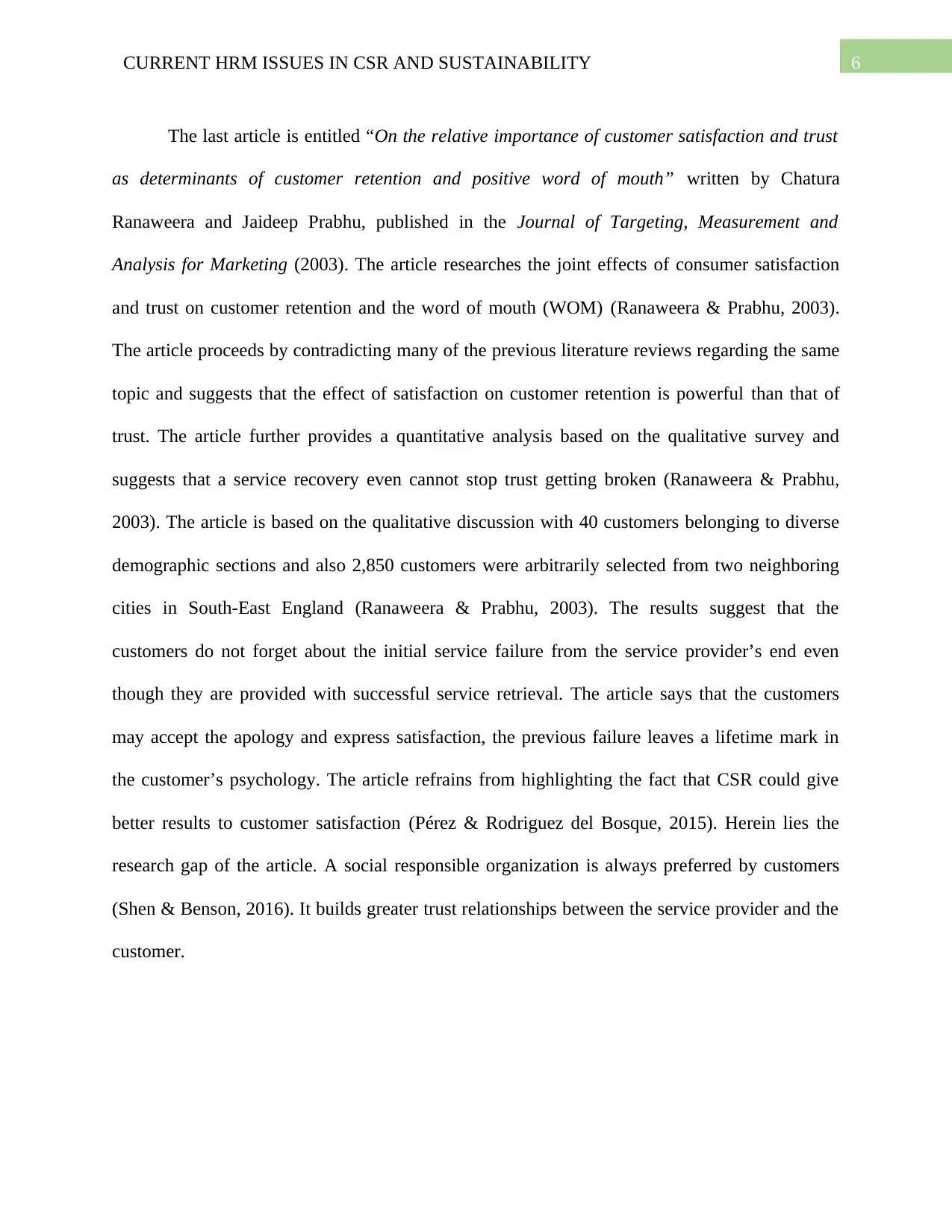
6CURRENT HRM ISSUES IN CSR AND SUSTAINABILITY
The last article is entitled “On the relative importance of customer satisfaction and trust
as determinants of customer retention and positive word of mouth” written by Chatura
Ranaweera and Jaideep Prabhu, published in the Journal of Targeting, Measurement and
Analysis for Marketing (2003). The article researches the joint effects of consumer satisfaction
and trust on customer retention and the word of mouth (WOM) (Ranaweera & Prabhu, 2003).
The article proceeds by contradicting many of the previous literature reviews regarding the same
topic and suggests that the effect of satisfaction on customer retention is powerful than that of
trust. The article further provides a quantitative analysis based on the qualitative survey and
suggests that a service recovery even cannot stop trust getting broken (Ranaweera & Prabhu,
2003). The article is based on the qualitative discussion with 40 customers belonging to diverse
demographic sections and also 2,850 customers were arbitrarily selected from two neighboring
cities in South-East England (Ranaweera & Prabhu, 2003). The results suggest that the
customers do not forget about the initial service failure from the service provider’s end even
though they are provided with successful service retrieval. The article says that the customers
may accept the apology and express satisfaction, the previous failure leaves a lifetime mark in
the customer’s psychology. The article refrains from highlighting the fact that CSR could give
better results to customer satisfaction (Pérez & Rodriguez del Bosque, 2015). Herein lies the
research gap of the article. A social responsible organization is always preferred by customers
(Shen & Benson, 2016). It builds greater trust relationships between the service provider and the
customer.
The last article is entitled “On the relative importance of customer satisfaction and trust
as determinants of customer retention and positive word of mouth” written by Chatura
Ranaweera and Jaideep Prabhu, published in the Journal of Targeting, Measurement and
Analysis for Marketing (2003). The article researches the joint effects of consumer satisfaction
and trust on customer retention and the word of mouth (WOM) (Ranaweera & Prabhu, 2003).
The article proceeds by contradicting many of the previous literature reviews regarding the same
topic and suggests that the effect of satisfaction on customer retention is powerful than that of
trust. The article further provides a quantitative analysis based on the qualitative survey and
suggests that a service recovery even cannot stop trust getting broken (Ranaweera & Prabhu,
2003). The article is based on the qualitative discussion with 40 customers belonging to diverse
demographic sections and also 2,850 customers were arbitrarily selected from two neighboring
cities in South-East England (Ranaweera & Prabhu, 2003). The results suggest that the
customers do not forget about the initial service failure from the service provider’s end even
though they are provided with successful service retrieval. The article says that the customers
may accept the apology and express satisfaction, the previous failure leaves a lifetime mark in
the customer’s psychology. The article refrains from highlighting the fact that CSR could give
better results to customer satisfaction (Pérez & Rodriguez del Bosque, 2015). Herein lies the
research gap of the article. A social responsible organization is always preferred by customers
(Shen & Benson, 2016). It builds greater trust relationships between the service provider and the
customer.
Paraphrase This Document
Need a fresh take? Get an instant paraphrase of this document with our AI Paraphraser
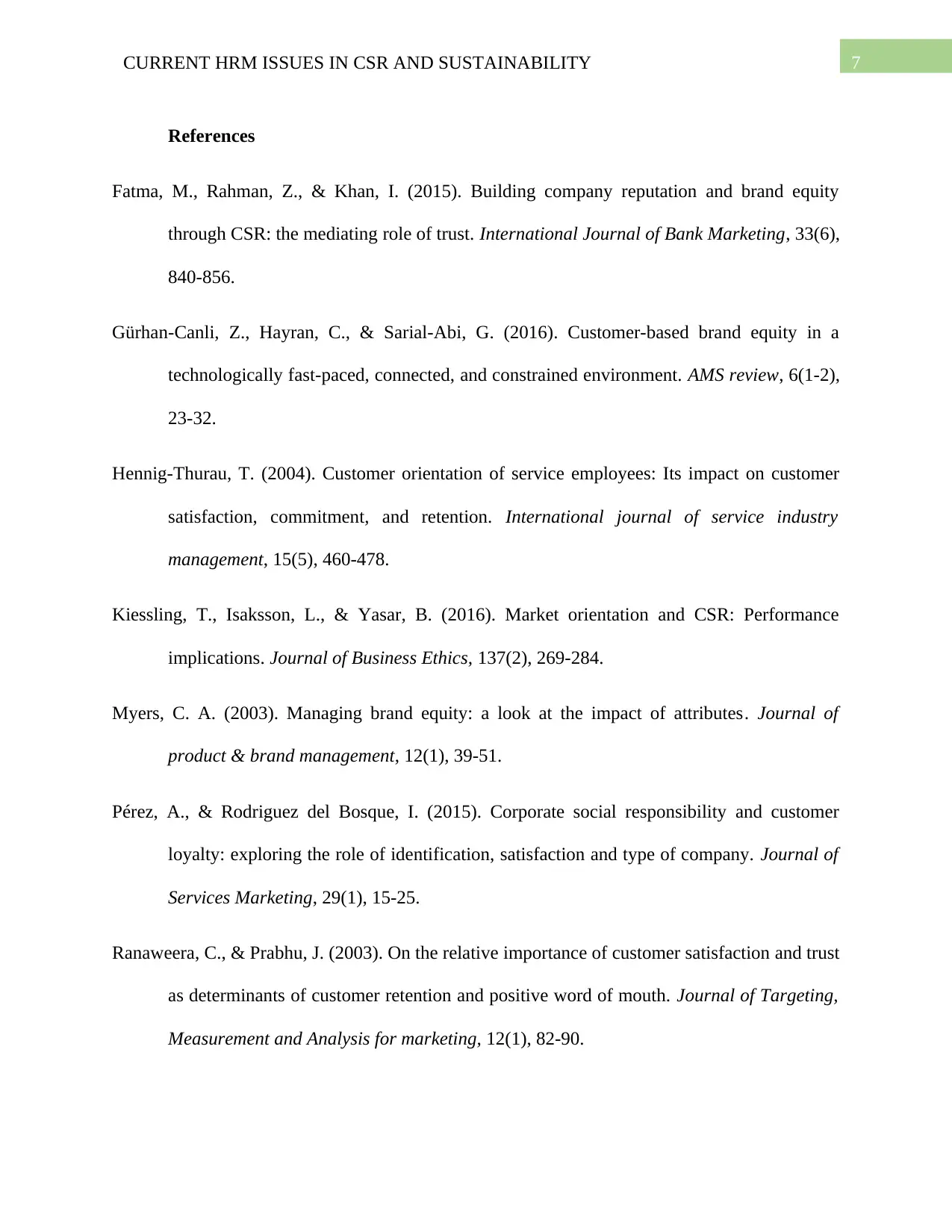
7CURRENT HRM ISSUES IN CSR AND SUSTAINABILITY
References
Fatma, M., Rahman, Z., & Khan, I. (2015). Building company reputation and brand equity
through CSR: the mediating role of trust. International Journal of Bank Marketing, 33(6),
840-856.
Gürhan-Canli, Z., Hayran, C., & Sarial-Abi, G. (2016). Customer-based brand equity in a
technologically fast-paced, connected, and constrained environment. AMS review, 6(1-2),
23-32.
Hennig-Thurau, T. (2004). Customer orientation of service employees: Its impact on customer
satisfaction, commitment, and retention. International journal of service industry
management, 15(5), 460-478.
Kiessling, T., Isaksson, L., & Yasar, B. (2016). Market orientation and CSR: Performance
implications. Journal of Business Ethics, 137(2), 269-284.
Myers, C. A. (2003). Managing brand equity: a look at the impact of attributes. Journal of
product & brand management, 12(1), 39-51.
Pérez, A., & Rodriguez del Bosque, I. (2015). Corporate social responsibility and customer
loyalty: exploring the role of identification, satisfaction and type of company. Journal of
Services Marketing, 29(1), 15-25.
Ranaweera, C., & Prabhu, J. (2003). On the relative importance of customer satisfaction and trust
as determinants of customer retention and positive word of mouth. Journal of Targeting,
Measurement and Analysis for marketing, 12(1), 82-90.
References
Fatma, M., Rahman, Z., & Khan, I. (2015). Building company reputation and brand equity
through CSR: the mediating role of trust. International Journal of Bank Marketing, 33(6),
840-856.
Gürhan-Canli, Z., Hayran, C., & Sarial-Abi, G. (2016). Customer-based brand equity in a
technologically fast-paced, connected, and constrained environment. AMS review, 6(1-2),
23-32.
Hennig-Thurau, T. (2004). Customer orientation of service employees: Its impact on customer
satisfaction, commitment, and retention. International journal of service industry
management, 15(5), 460-478.
Kiessling, T., Isaksson, L., & Yasar, B. (2016). Market orientation and CSR: Performance
implications. Journal of Business Ethics, 137(2), 269-284.
Myers, C. A. (2003). Managing brand equity: a look at the impact of attributes. Journal of
product & brand management, 12(1), 39-51.
Pérez, A., & Rodriguez del Bosque, I. (2015). Corporate social responsibility and customer
loyalty: exploring the role of identification, satisfaction and type of company. Journal of
Services Marketing, 29(1), 15-25.
Ranaweera, C., & Prabhu, J. (2003). On the relative importance of customer satisfaction and trust
as determinants of customer retention and positive word of mouth. Journal of Targeting,
Measurement and Analysis for marketing, 12(1), 82-90.
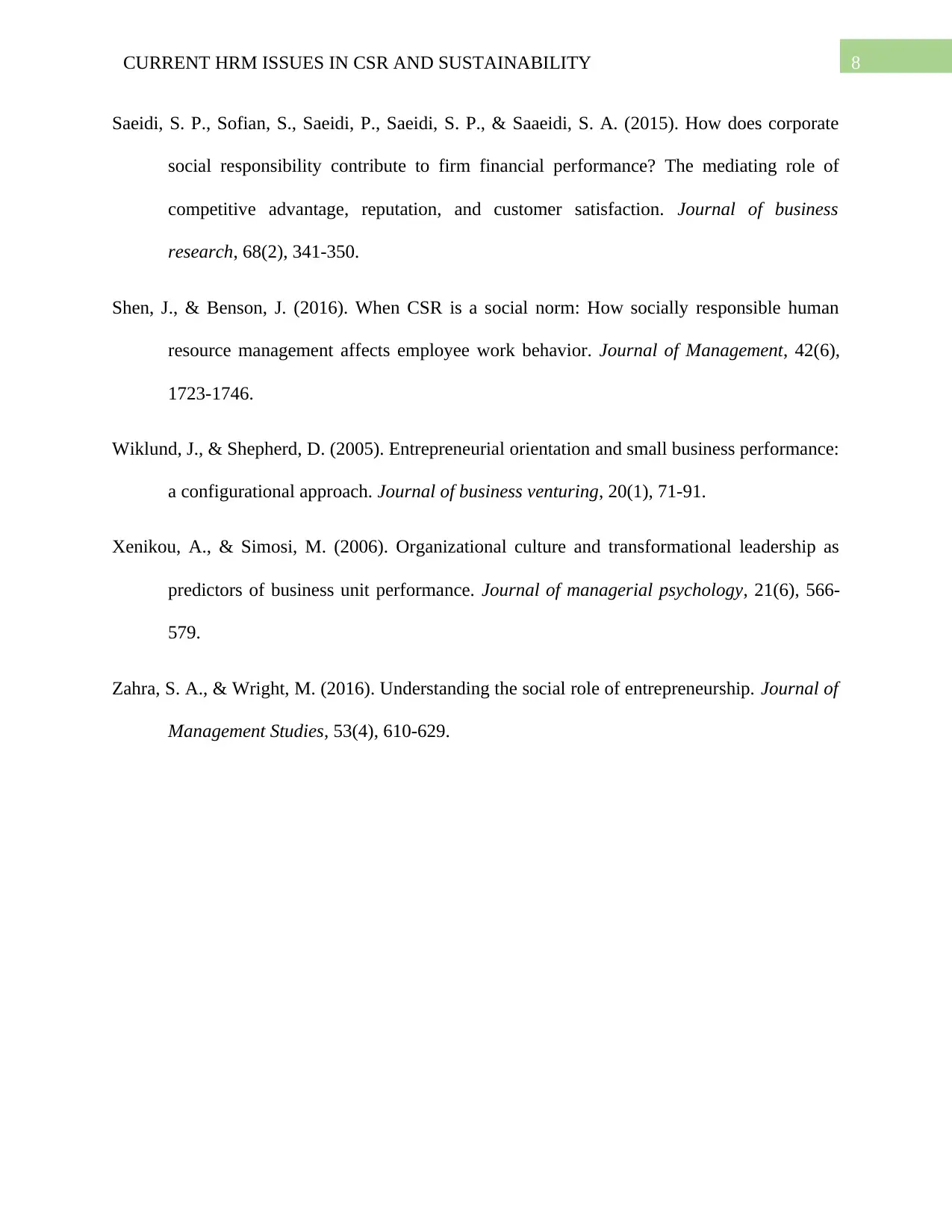
8CURRENT HRM ISSUES IN CSR AND SUSTAINABILITY
Saeidi, S. P., Sofian, S., Saeidi, P., Saeidi, S. P., & Saaeidi, S. A. (2015). How does corporate
social responsibility contribute to firm financial performance? The mediating role of
competitive advantage, reputation, and customer satisfaction. Journal of business
research, 68(2), 341-350.
Shen, J., & Benson, J. (2016). When CSR is a social norm: How socially responsible human
resource management affects employee work behavior. Journal of Management, 42(6),
1723-1746.
Wiklund, J., & Shepherd, D. (2005). Entrepreneurial orientation and small business performance:
a configurational approach. Journal of business venturing, 20(1), 71-91.
Xenikou, A., & Simosi, M. (2006). Organizational culture and transformational leadership as
predictors of business unit performance. Journal of managerial psychology, 21(6), 566-
579.
Zahra, S. A., & Wright, M. (2016). Understanding the social role of entrepreneurship. Journal of
Management Studies, 53(4), 610-629.
Saeidi, S. P., Sofian, S., Saeidi, P., Saeidi, S. P., & Saaeidi, S. A. (2015). How does corporate
social responsibility contribute to firm financial performance? The mediating role of
competitive advantage, reputation, and customer satisfaction. Journal of business
research, 68(2), 341-350.
Shen, J., & Benson, J. (2016). When CSR is a social norm: How socially responsible human
resource management affects employee work behavior. Journal of Management, 42(6),
1723-1746.
Wiklund, J., & Shepherd, D. (2005). Entrepreneurial orientation and small business performance:
a configurational approach. Journal of business venturing, 20(1), 71-91.
Xenikou, A., & Simosi, M. (2006). Organizational culture and transformational leadership as
predictors of business unit performance. Journal of managerial psychology, 21(6), 566-
579.
Zahra, S. A., & Wright, M. (2016). Understanding the social role of entrepreneurship. Journal of
Management Studies, 53(4), 610-629.
1 out of 9
Your All-in-One AI-Powered Toolkit for Academic Success.
+13062052269
info@desklib.com
Available 24*7 on WhatsApp / Email
![[object Object]](/_next/static/media/star-bottom.7253800d.svg)
Unlock your academic potential
© 2024 | Zucol Services PVT LTD | All rights reserved.





